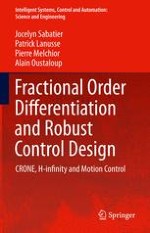2015 | Book
Fractional Order Differentiation and Robust Control Design
CRONE, H-infinity and Motion Control
Authors: Jocelyn Sabatier, Patrick Lanusse, Pierre Melchior, Alain Oustaloup
Publisher: Springer Netherlands
Book Series : Intelligent Systems, Control and Automation: Science and Engineering
